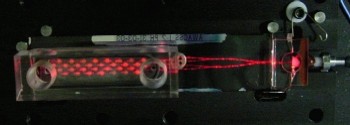
It is based around a sodium-doped glass slide with 3×3µm potassium-doped waveguides in its surface.
“The potassium gives it a higher refractive index, so these waveguides work like optical fibres,” Professor James Wilkinson of the Optoelectronics Research Centre told Electronics Weekly.
An overall coating of low index SiO2 separates the optics from anything on the slide’s surface.
Implanted optical splitters divide an incoming 635nm laser beam between 32 patches, exposed to water samples through 0.1x1mm windows in the SiO2.
Coatings over the windows attract specific pollutants to which florescent markers have been attached.
Behind the glass slide, 32 1mm diameter plastic optical fibres carry samples of any fluorescence to PIN opto-diodes through a filter to remove the original laser wavelength.
 Electronics Weekly Electronics Design & Components Tech News
Electronics Weekly Electronics Design & Components Tech News



